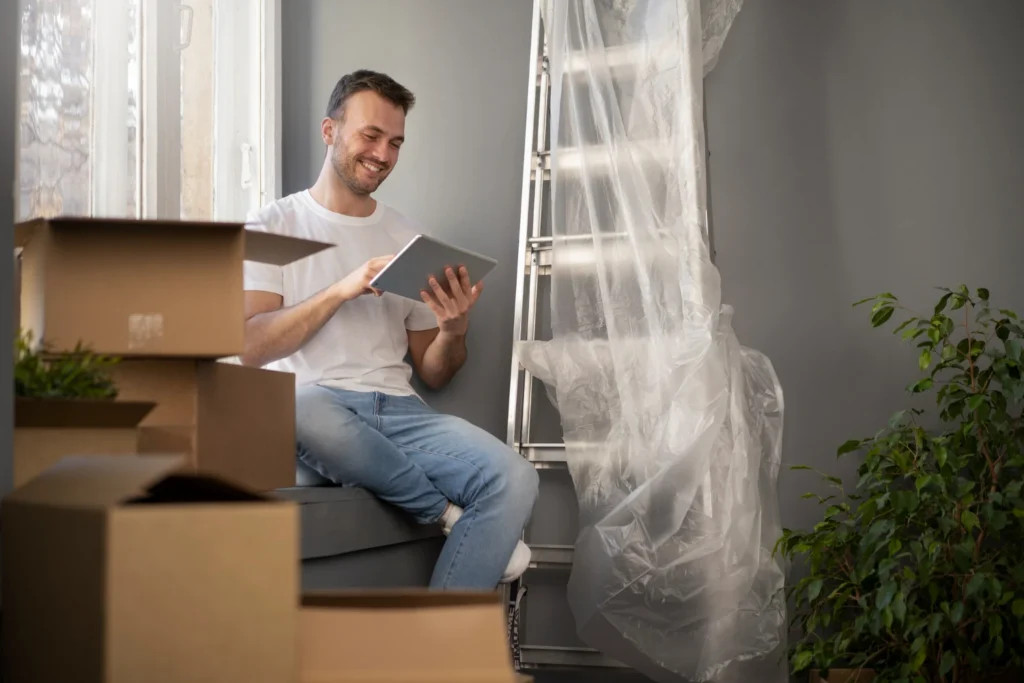Moving to a new home can be an exciting adventure, but let’s be honest—it can also be overwhelming and stressful.
However, with the right moving hacks, you can make the entire process much faster, easier, and far less stressful.
In this blog, we’ll share some tried-and-true tips and tricks to streamline your next move. If things still feel overwhelming, you can always rely on professional help from a trusted moving or packing services to make your move hassle-free.
1. Declutter Before Packing
Before you even begin to pack, it’s a good idea to declutter. Moving items that you no longer need only adds to the effort and costs you time. By getting rid of unused belongings, you not only make the packing process easier but also reduce the number of boxes to move.
- Tip: Separate items into categories like donate, sell, recycle, or throw away. This helps you organize your life and start fresh in your new home with fewer unnecessary items.
2. Pack a Moving Essentials Box
It’s important to keep the essentials close during a move. An “essentials” box should include all the items you’ll need right away after moving into your new place. Think about things like toiletries, phone chargers, medications, and snacks. You don’t want to be searching through dozens of boxes to find your toothbrush or phone charger after a long day of moving.
- Tip: Keep this box in your car or with you, rather than sending it on the moving truck, so it’s easy to access when needed.
3. Label Boxes by Room and Priority
To avoid confusion when you arrive at your new home, label each box by the room it belongs to and its unpacking priority. This helps movers place boxes in the correct rooms and allows you to unpack in an organized manner.
- Tip: Use color-coded labels or colored tape for each room. For instance, green labels could be for kitchen items and blue for the bedroom. This system speeds up the process of sorting out boxes when you arrive.
4. Take Pictures of Electronics Setup
Before you unplug your electronics, snap a photo of the setup, particularly the wiring of your TV, gaming consoles, or computer setup. This makes reassembling them easier since you’ll know exactly where each cable goes.
- Tip: Group cords and cables together in a labeled plastic bag and tape them to the corresponding electronics to keep everything organized.
5. Use Soft Items for Padding
Instead of buying excessive bubble wrap or packing peanuts, use what you already have—like towels, sheets, and clothes—to pack fragile items. This saves space, cuts costs, and makes the move more environmentally friendly.
- Tip: Wrap glasses or mugs in socks. This provides good padding and helps keep them scratch-free.
6. Pack Hanging Clothes in Garbage Bags
Packing your hanging clothes can be time-consuming if you remove them from their hangers. Instead, pull large garbage bags over your clothes while they’re still hanging. Tie the bags at the top to keep them together, which helps prevent wrinkles and makes unpacking easier.
- Tip: Use sturdy, heavy-duty garbage bags to avoid ripping during the move, especially for heavier or bulkier clothing items.
7. Keep Hardware Together
When disassembling furniture, place screws, bolts, and other small hardware in labeled plastic bags. Tape the bags to the furniture pieces they belong to, ensuring you won’t lose any vital parts during the move.
- Tip: Write down or take photos of how the furniture was assembled to make putting it back together easier.
8. Roll, Don’t Fold Clothes
Rolling your clothes instead of folding them can save space in boxes and luggage. It also minimizes wrinkles, so you won’t have to iron or press clothes once you unpack.
- Tip: This method is particularly useful for packing items like t-shirts, pants, and small garments.
9. Use Suitcases for Heavy Items
Rather than lifting heavy boxes of books or tools, pack them into rolling suitcases. This way, you can easily transport heavier items without straining your back.
- Tip: Be mindful of weight distribution to avoid making the suitcase too heavy or unstable to roll.
10. Wrap Breakables in Clothing
Another great way to save on packing supplies is by wrapping breakable items, such as dishes or glassware, in clothing. This dual-purpose method saves space and adds protection for fragile items.
- Tip: Towels and thicker clothing items work best for cushioning breakables.

11. Pack Plates Vertically
When packing dishes, arrange them vertically rather than stacking them flat. This reduces the likelihood of breakage during transit because vertical packing distributes the pressure more evenly.
- Tip: Place soft padding between plates, such as dish towels or foam sheets, for extra protection.
12. Cover Furniture with Stretch Wrap
To prevent scratches, dents, or other damage during the move, wrap your furniture with stretch wrap. This also helps keep drawers or cabinet doors from opening in transit.
- Tip: For extra protection, use blankets under the stretch wrap to protect delicate surfaces.
13. Use Small Boxes for Heavy Items
Packing heavy items into smaller boxes makes them easier to carry and reduces the risk of injury or damage. Avoid overloading large boxes, as this can make them hard to lift.
- Tip: Use boxes no larger than a typical shoebox for heavier items like books or canned goods.
14. Pack a First-Day Essentials Kit
When you arrive at your new home, you’ll likely be too tired to unpack everything. A first-day essentials kit can include things like cleaning supplies, a flashlight, trash bags, and kitchen essentials.
- Tip: Include items like toilet paper and a shower curtain in case you need to freshen up before unpacking everything.
15. Protect Floors During the Move
Moving heavy furniture or appliances can damage floors, especially hardwood or carpets. Use furniture sliders, towels, or cardboard to protect the floor while moving heavy objects.
- Tip: For hardwood floors, consider placing felt pads or blankets underneath furniture to prevent scratches.
16. Use Color-Coded Tape for Box Labeling
To further simplify the moving process, assign a color to each room (e.g., blue for the kitchen, green for the bedroom) and use corresponding colored tape on boxes. This helps movers quickly identify which boxes go where.
- Tip: Stick matching colored labels on the doors of your new home so movers can place boxes in the correct rooms without constant supervision.
17. Take Pictures of Valuable Items
Before packing any valuable or fragile items, take photos of their condition. In case of damage during the move, these photos can serve as evidence when filing insurance claims.
- Tip: Keep these photos saved with other moving documents for easy access.
18. Store Liquids Separately
Pack liquids like cleaning supplies, toiletries, or kitchen items in separate plastic bins. This prevents potential leaks or spills from damaging your other belongings.
- Tip: Use tape to seal lids and pack them upright to avoid accidents.
19. Use Egg Cartons for Small Items
Use egg cartons to store small, fragile items like jewelry or glass trinkets. The individual compartments provide protection and keep small items organized during the move.
- Tip: Tape the cartons shut to keep the contents secure.
20. Pre-Clean Your New Home
Before you move in, clean your new home. It’s much easier to clean an empty house than it is once the furniture is in place. A clean slate also makes unpacking more enjoyable.
- Tip: If possible, visit your new home a few days before the move to handle cleaning or hire a professional cleaning service.
Make Your Next Move Stress-Free
With these moving hacks, you can make your next move faster, easier, and a lot less stressful. From decluttering to labeling boxes and using household items for padding, these small tips can make a big difference. And if you want to take the stress completely out of the process, let AFA Movers handle everything for you.
Call AFA Movers at 832-898-8808 today to schedule your move and enjoy a stress-free relocation!



